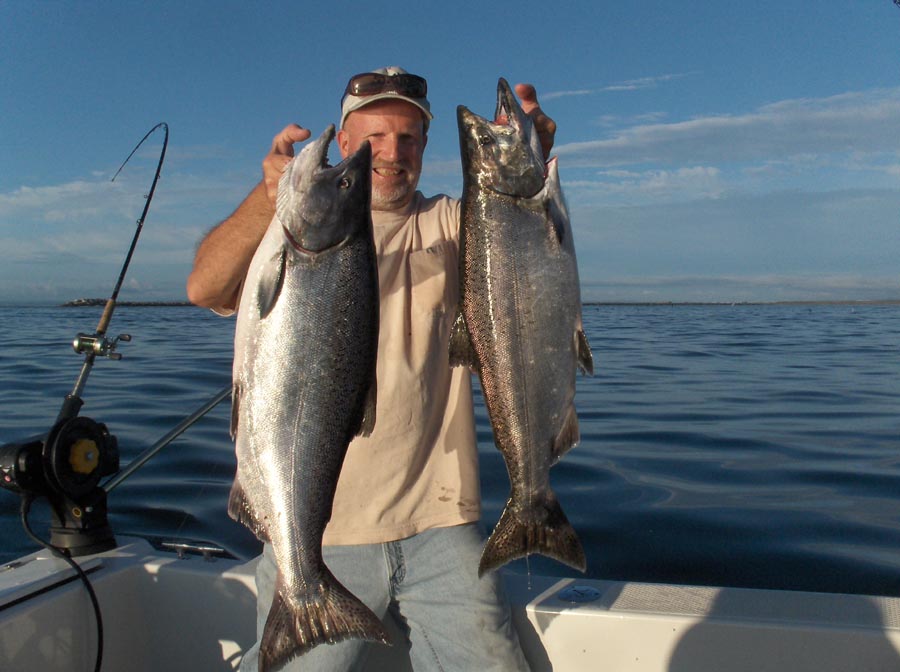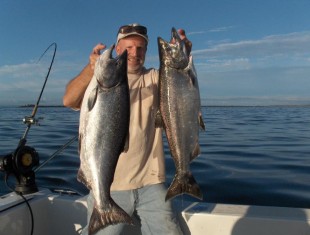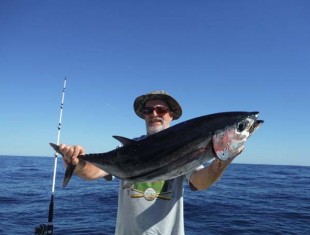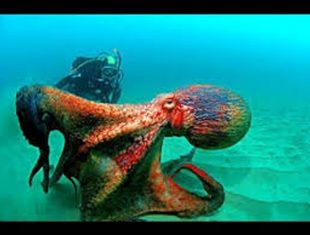
I caught my first salmon on a cold, windy January morning in 1960 fishing with my grandfather Cecil Baldwin near Tahuya on Hood Canal. With a south wind blowing 15-20 mph the waves looked pretty big in the eyes of a six-year-old boy.
My grandfather was a short but powerful man and was having no problem rowing the 12-foot flat bottom plywood pram in the semi-stormy conditions. I remember feeling as safe as sitting in the living room watching cartoons.
We had two lines out using herring spinners he had expertly cut from the sides of some extra large herring the night before. From years of experience he knew the exact angles to cut to make the perfect spin for catching king salmon.
About 15 minutes into our fishing venture, I felt a strong tug on the end of my line. Because of the weather conditions my grandfather had to man the oars so it was up to me to reel the 18-pound beast that probably weighed one-third as much as me. Somehow we managed to get it in the net and the party was on, well not really but we were sure happy.
For the next six years we did a lot salmon fishing together and were usually successful, and then an unexpected event changed my life somewhat.
Three months after he retired he somehow fell out of his eight-foot pram while trout fishing on Wooten Lake with his hip boots on and drowned. That was pretty much the end of my fishing days until after high school.
In 1973 while working in the family business at Sande Boat Works I bought a 16-foot Glasply with a 1968 100-horse power outboard and started fishing Puget Sound, Neah Bay and Westport.
As a kid catching all those salmon I was always curious about those strange looking little parasites that hung on the skin near the bottom fin just in front of the tail. In the last 50 years, marine scientists have learned a lot about these pesky little creatures that have been affecting salmon for millions of years.
The sea louse or sea lice is a copepod external parasite that attaches to the skin of salmon and sea-going trout to feed on mucus, tissue and blood for its existence. These little suckers have a short but busy life cycle of about eight months and go through eight life stages before their final adult stage.
The adult female sea lice releases a pair of egg-strings with hundreds of eggs that hatch and float near the surface. She might do this 10 times during her short life.
The first stage lasts about a day then they molt into stage two and are still feeding on their egg sac reserves. At this stage they can’t swim against the current but do travel up near the surface during the day and sink back down at night.
Stage two lasts for about 10 days. Now they somehow need to find a salmon to attach itself and molt again to start their parasite stage and begin feeding.
A few more 10-day molts later they can move around the skin to better feeding areas without falling off their host.
After a few more molts they are finally at the mature adult phase. At this stage they can swim pretty well and can even change hosts.
Coho and pink salmon seem to have some resistance to sea lice by releasing some chemicals the lice don’t like after a week or so of attachment and they may then leave to find a new host.
In the last 30 years, salmon farms have changed how we view sea lice. Thousands and thousands of penned up salmon have made for sea lice heaven. This can be a huge problem for migrating small salmon swimming past these salt water salmon pens. A handful of sea lice can kill a small salmon because their skin is so thin and they don’t have the blood and fat reserves large fish do.
In the last ten years, salmon farms have been spending millions of dollars on the sea lice problem. It’s been a huge challenge with limited success.
Norway is trying to reduce sea lice at their farms to 0.1 sea lice per fish, which is difficult and expensive, but at that rate small wild salmon migrating through the area seem to be doing much better.
Salmon pen bath treatments are labor intensive and stressful on the fish.
It appears sea lice are mutating and making some of the chemicals less effective at controlling them.
Emamectin benzoate is the active agent in the formulation SLICE, which is put in the salmon feed for a week and works pretty good for the next two months.
Vaccines are being worked on, but noting yet works.
We really don’t know what any of these chemicals do to people if they eat a lot of salmon. But most people don’t eat farmed salmon that often anyway.
When it comes right down to it, there are many other things to be concerned about in this world. Like, what lure am I going to use to catch my next king salmon?



